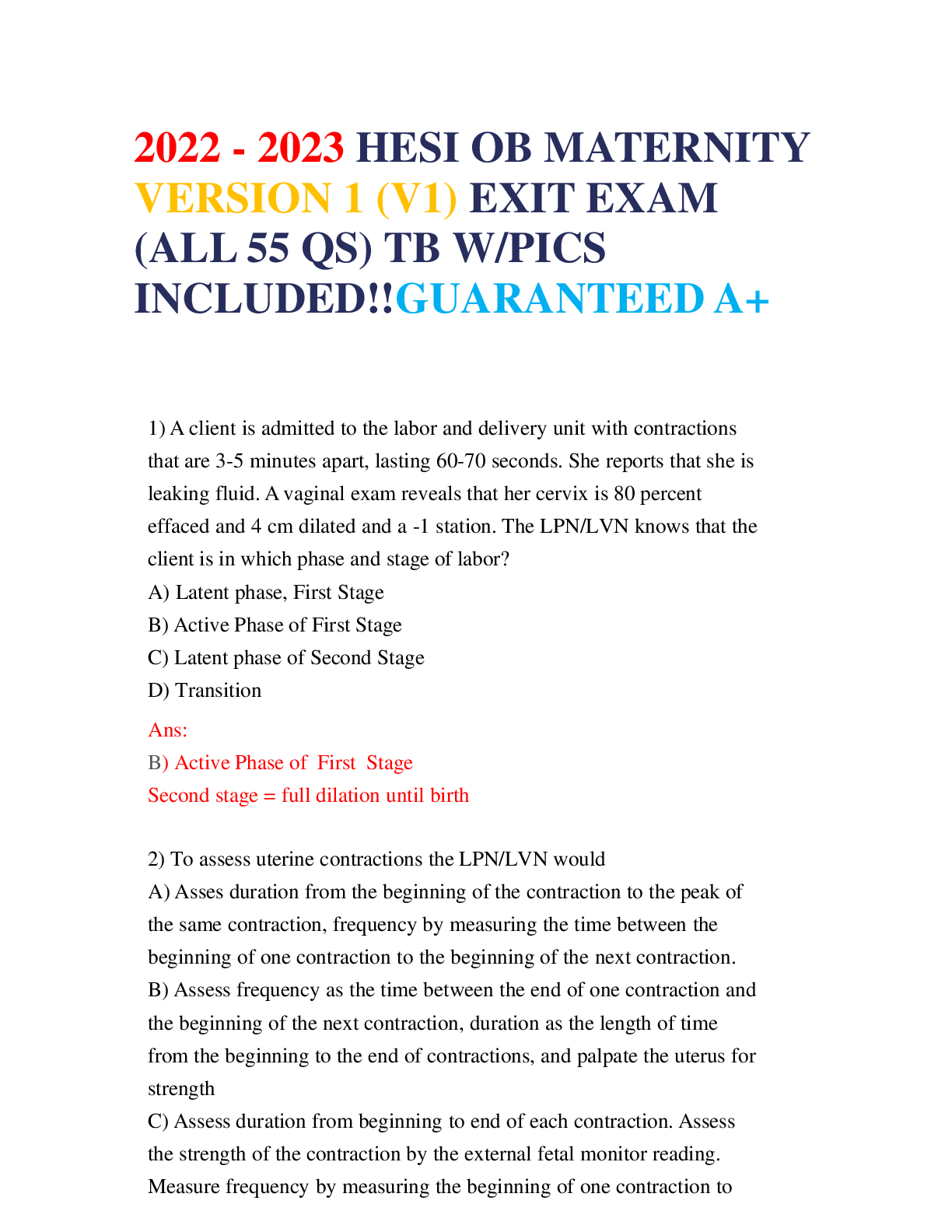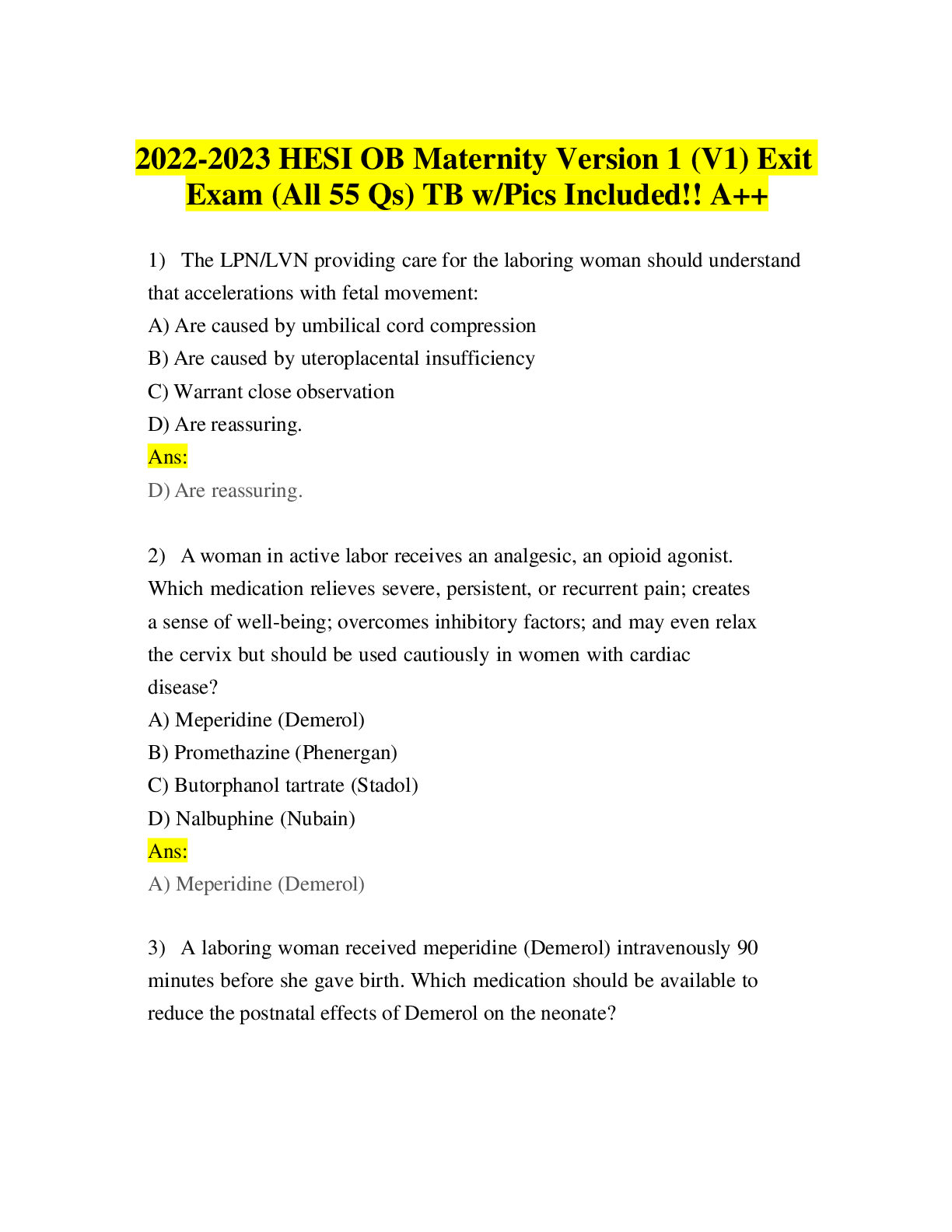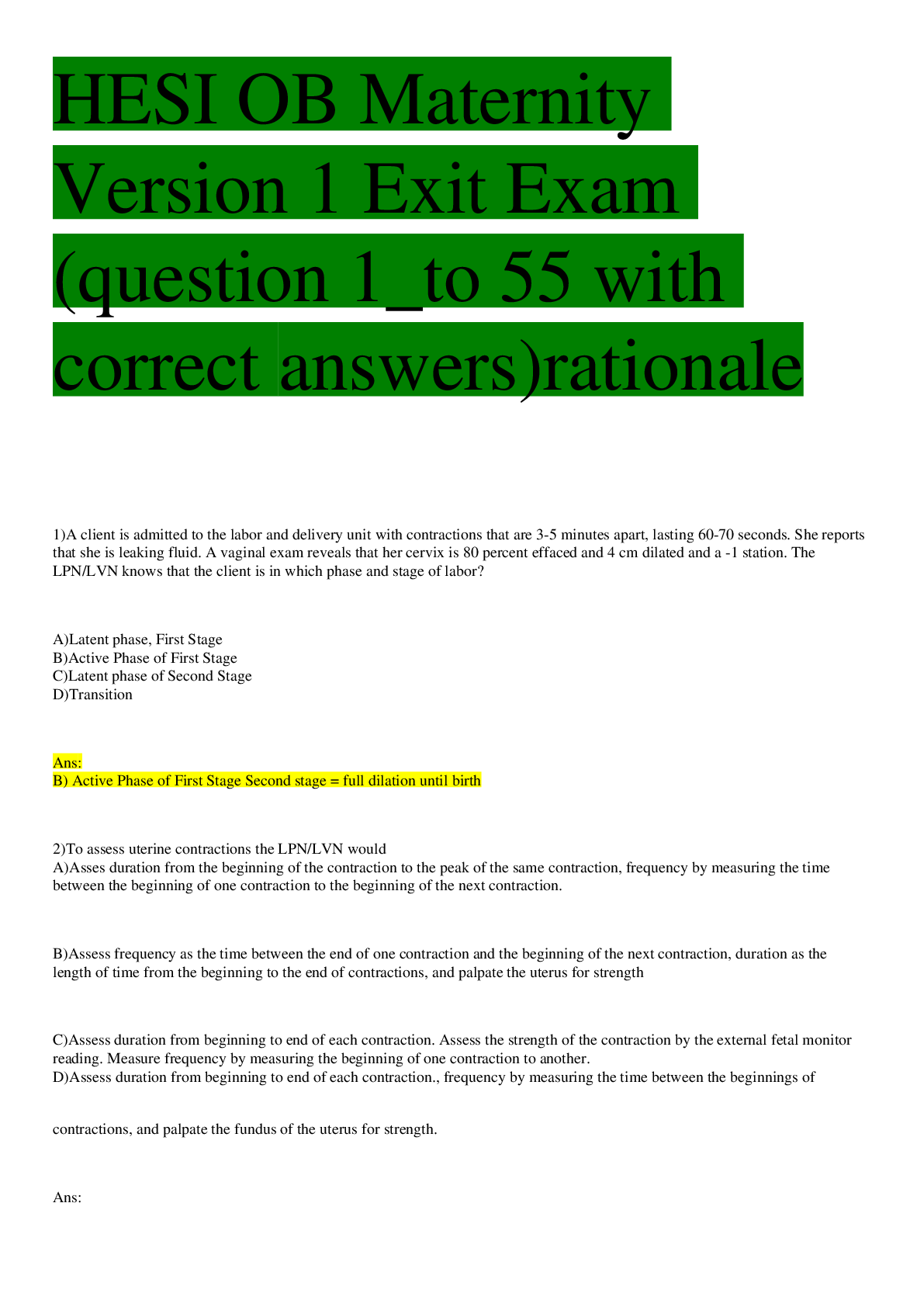HESI OB Maternity > EXAM > 2022 - 2023 HESI OB Maternity Version 1 (V1) Exit Exam (All 55 Qs) TB w Pics Included!! A++ (All)
2022 - 2023 HESI OB Maternity Version 1 (V1) Exit Exam (All 55 Qs) TB w Pics Included!! A++
Document Content and Description Below
1) A client is admitted to the labor and delivery unit with contractions that are 3-5 minutes apart, lasting 60-70 seconds. She reports that she is leaking fluid. A vaginal exam reveals that her cervi... x is 80 percent effaced and 4 cm dilated and a -1 station. The LPN/LVN knows that the client is in which phase and stage of labor? A) Latent phase, First Stage B) Active Phase of First Stage C) Latent phase of Second Stage D) Transition Ans: B) Active Phase of First Stage Second stage = full dilation until birth 2) To assess uterine contractions the LPN/LVN would A) Asses duration from the beginning of the contraction to the peak of the same contraction, frequency by measuring the time between the beginning of one contraction to the beginning of the next contraction. B) Assess frequency as the time between the end of one contraction and the beginning of the next contraction, duration as the length of time from the beginning to the end of contractions, and palpate the uterus for strength C) Assess duration from beginning to end of each contraction. Assess the strength of the contraction by the external fetal monitor reading. Measure frequency by measuring the beginning of one contraction to another. D) Assess duration from beginning to end of each contraction., frequency by measuring the time between the beginnings of contractions, and palpate the fundus of the uterus for strength. Ans: D) Assess duration from beginning to end of each contraction., frequency by measuring the time between the beginnings of contractions, and palpate the fundus of the uterus for strength. 3) Which basic type of pelvis includes the correct description and percentage of occurrence in women? A) Platypelloid: flattened, wide, shallow; 3% B) Anthropoid: resembling the ape; narrower; 10% C) Android: resembling the male; wider oval; 15% D) Gynecoid: classic female; heart shaped; 75% Ans: A) Platypelloid: flattened, wide, shallow; 3% 4) What position would be least effective when gravity is desired to assist in fetal descent? A) Lithotomy B) Walking C) Kneeling D) Sitting Ans: A) Lithotomy 5) The factors that affect the process of labor and birth, known commonly as the five Ps, include all EXCEPT: A) Passageway. B) Powers. C) Passenger. D) Pressure. D) Pressure. Ans: :: The 5 P's are: 1. Powers (contractions) 2. Passengers (fetus & placenta) 3. Passageway (birth canal) 4. Position (of the mother) 5. Psychological Response 6) While evaluating an external monitor tracing of a woman in active labor, the nurse notes that the fetal heart rate (FHR) for five sequential contractions begins to decelerate late in the contraction, with the nadir of the decelerations occurring after the peak of the contraction. The LPN/LVN first priority is to: A) Notify the care provider. B) Assist with amnioinfusion C) Change the woman's position D) Insert a scalp electrode. Ans: C) Change the woman's position 7) During labor a fetus with an average heart rate of 175 beats/min over a 15-minute period would be considered to have: A) A normal baseline heart rate. B) Bradycardia. C) Hypoxia. D) Tachycardia. Ans: D) Tachycardia. 8) As a perinatal LPN/LVN you realize that a fetal heart rate that is tachycardic, is bradycardic, or has late decelerations with loss of variability is nonreassuring and is associated with A) Cord compression B) Hypotension C) Hypoxemia/acidemia D) Maternal drug use. Ans: C) Hypoxemia/acidemia 9) The LPN/LVN providing care for the laboring woman should understand that amnioinfusion is used to treat: A) Fetal tachycardia. B) Fetal bradycardia. C) Variable decelerations D) Late decelerations. Ans: C) Variable decelerations 10) The most common cause of decreased variability in the fetal heart rate (FHR) that lasts 30 minutes or less is: A) Fetal hypoxemia B) Fetal sleep cycles C) Altered cerebral blood flow. D) Umbilical cord compression. Ans: B) Fetal sleep cycles 11) While evaluating an external monitor tracing of a woman in active labor whose labor is being induced, the nurse notes that the fetal heart rate (FHR) begins to decelerate in a slow curve at the onset of several contractions and returns to baseline before each contraction ends. The LPN/LVN should: A) Insert an internal monitor B) Document the finding in the client's record. C) Discontinue the oxytocin infusion D) Change the woman's position Ans: B) Document the finding in the client's record. 12) What three measures should the nurse implement to provide intrauterine resuscitation? Select the response that best indicates the priority of actions that should be taken. A) Reposition the mother, increase intravenous (IV) fluid, and provide oxygen via face mask. B) Perform a vaginal examination, reposition the mother, and provide oxygen via face mask. C) Administer oxygen to the mother, increase IV fluid, and notify the care provider. D) Call the provider, reposition the mother, and perform a vaginal examination Ans: A) Reposition the mother, increase intravenous (IV) fluid, and provide oxygen via face mask. 13) When using intermittent auscultation (IA) to assess uterine activity, LPN/LVN should be aware that: A) The resting tone between contractions is described as either placid or turbulent B) The examiner's hand should be placed over the fundus before, during, and after contractions. C) The frequency and duration of contractions is measured in seconds for consistency D) Contraction intensity is given a judgment number of 1 to 7 by the nurse and client together. Ans: B) The examiner's hand should be placed over the fundus before, during, and after contractions. 14) Perinatal LPN/LVN are legally responsible for: A) Applying the external fetal monitor and notifying the care provider. B) Correctly interpreting fetal heart rate (FHR) patterns, initiating appropriate nursing interventions, and documenting the outcomes. C) Greeting the client on arrival, assessing her, and starting an intravenous line. D) Making sure that the woman is comfortable. Ans: B) Correctly interpreting fetal heart rate (FHR) patterns, initiating appropriate nursing interventions, and documenting the outcomes. 15) The LPN/LVN providing care for the laboring woman should understand that late fetal heart rate (FHR) decelerations are caused by: A) Altered cerebral blood flow B) Spontaneous rupture of membranes C) Uteroplacental insufficiency D) Umbilical cord compression Ans: C) Uteroplacental insufficiency 16) The LPN/LVN providing care for the laboring woman should understand that variable fetal heart rate (FHR) decelerations are caused by: A) Umbilical cord compression. B) Altered fetal cerebral blood flow C) Fetal hypoxemia. D) Uteroplacental insufficiency Ans: A) Umbilical cord compression. 17) Which of the following is NOT a reassuring component of the fetal heart rate A) FHR of 114 B) Accelerations of the FHR C) Moderate Variability D) Absent FHR Variability Ans: D) Absent FHR Variability 18) You are evaluating the fetal monitor tracing of your client, who is in active labor. Suddenly you see the fetal heart rate (FHR) drop from its baseline of 125 down to 80. You reposition the mother, provide oxygen, increase intravenous (IV) fluid, and perform a vaginal examination. The cervix has not changed. Five minutes have passed, and the fetal heart rate remains in the 80s. What additional nursing measures should you take? A) Call for help and Notify the care provider immediately B) Start pitocin C) Have her empty her bladder D) Insert a Foley catheter Ans: A) Call for help and Notify the care provider immediately 19) What is an advantage of external electronic fetal monitoring? A) Once correctly applied by the nurse, the transducer need not be repositioned even when the woman changes positions. B) The tocotransducer can measure and record the frequency, regularity, intensity, and approximate duration of uterine contractions (UCs). C) The external EFM does not require rupture of membranes or introduction of scalp electrode or IUPC which may introduce risk of infection or fetal scarring. D) The external EFM can accurately record FHR all the time. Ans: C) The external EFM does not require rupture of membranes or introduction of scalp electrode or IUPC which may introduce risk of infection or fetal scarring. 20) A number of methods to assist in the assessment of fetal well-being have been developed for use in conjunction with electronic fetal monitoring. These various technologies assist in supporting interventions for a nonreassuring fetal heart rate pattern when necessary. The labor and delivery nurse should be aware that one of these modalities, fetal oxygen saturation monitoring, includes the use of: A) Fetal blood sampling B) Umbilical cord acid-base determination C) Fetal pulse oximetry. D) A fetal acoustic stimulator. Ans: C) Fetal pulse oximetry. 21) The LPN/LVN caring for the woman in labor should understand that maternal hypotension can result in: A) Uteroplacental insufficiency. B) Spontaneous rupture of membranes C) Fetal dysrhythmias. D) Early decelerations. Ans: A) Uteroplacental insufficiency. 22) The LPN/LVN providing care for the laboring woman should understand that accelerations with fetal movement: A) Are caused by umbilical cord compression B) Are caused by uteroplacental insufficiency C) Warrant close observation D) Are reassuring. Ans: D) Are reassuring. 23) A woman in active labor receives an analgesic, an opioid agonist. Which medication relieves severe, persistent, or recurrent pain; creates a sense of well-being; overcomes inhibitory factors; and may even relax the cervix but should be used cautiously in women with cardiac disease? A) Meperidine (Demerol) B) Promethazine (Phenergan) C) Butorphanol tartrate (Stadol) D) Nalbuphine (Nubain) Ans: A) Meperidine (Demerol) 24) A laboring woman received meperidine (Demerol) intravenously 90 minutes before she gave birth. Which medication should be available to reduce the postnatal effects of Demerol on the neonate? A) Fentanyl (Sublimaze) B) Promethazine (Phenergan) C) Naloxone (Narcan) D) Nalbuphine (Nubain) Ans: C) Naloxone (Narcan) 25) A woman in labor has just received an epidural block. The most important nursing intervention is to: A) Limit parenteral fluids. B) Monitor the fetus for possible tachycardia C) Monitor the maternal blood pressure for possible hypotension. D) Monitor the maternal pulse for possible bradycardia Ans: C) Monitor the maternal blood pressure for possible hypotension. 26) A woman is experiencing back labor and complains of intense pain in her lower back. An effective relief measure would be to use: A) Counterpressure against the sacrum B) Pant-blow (breaths and puffs) breathing techniques C) Effleurage. D) Conscious relaxation or guided imagery. Ans: A) Counterpressure against the sacrum 27) A woman has requested an epidural for her pain. She is 5 cm dilated and 100% effaced. The baby is in a vertex position and is engaged. The LPN/LVN increases the woman's intravenous fluid for a pre-procedural bolus. She reviews her laboratory values and notes that the woman's hemoglobin is 12 g/dl, hematocrit is 38%, platelets are 67,000, and white blood cells (WBCs) are 12,000/mm3. Which factor would contraindicate an epidural for the woman? A) She is too far dilated B) She is anemic. C) She has thrombocytopenia D) She is septic Ans: C) She has thrombocytopenia 28) The role of the LPN/LVN with regard to informed consent is to: A) Inform the client about the procedure and have her sign the consent form. B) Act as a client advocate and help clarify the procedure and the options. C) Call the physician to see the client D) Witness the signing of the consent form. B) Act as a client advocate and help clarify the procedure and the options. [Show More]
Last updated: 11 months ago
Preview 1 out of 16 pages
Instant download
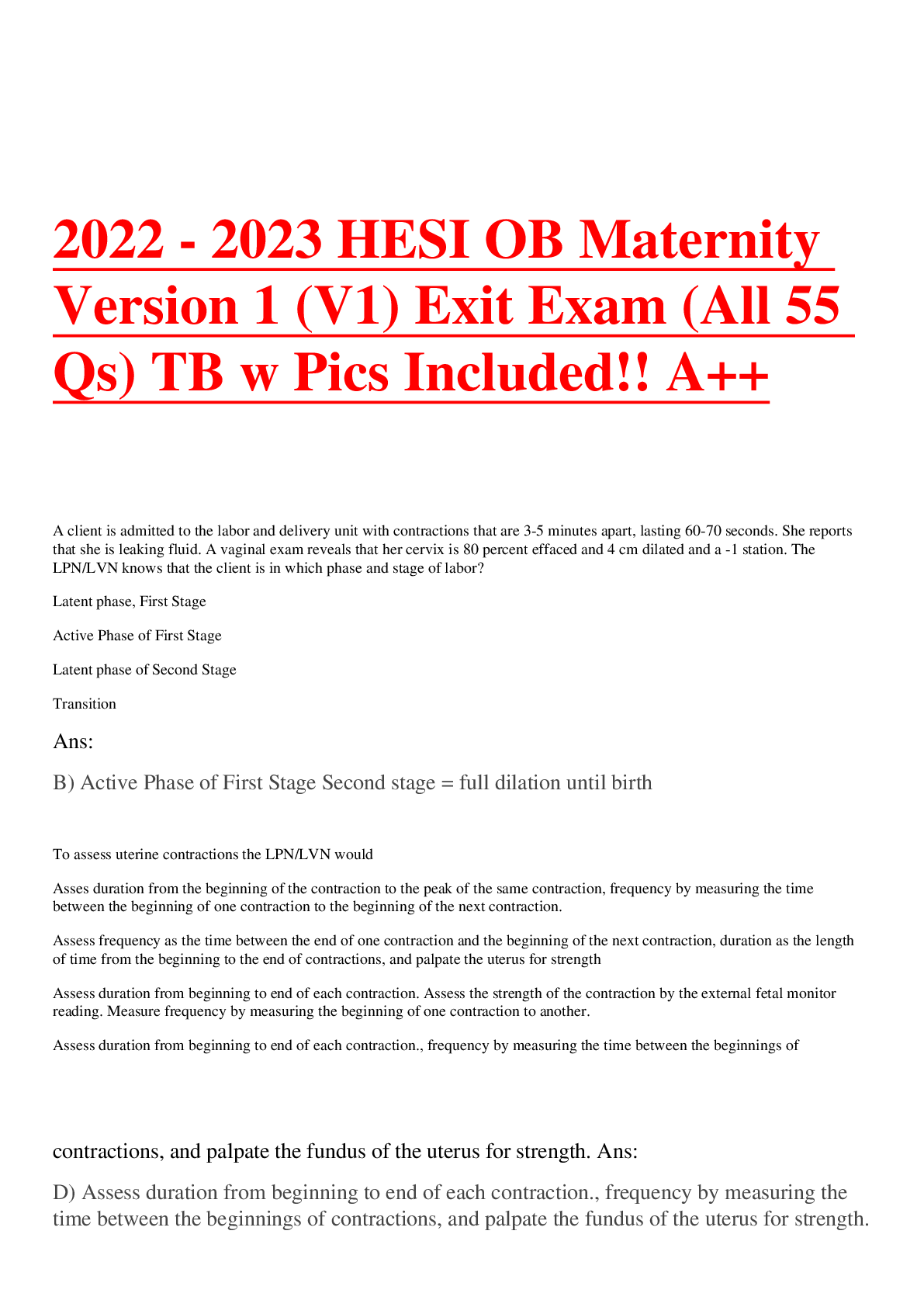
Buy this document to get the full access instantly
Instant Download Access after purchase
Add to cartInstant download
Reviews( 0 )
Document information
Connected school, study & course
About the document
Uploaded On
Jun 28, 2023
Number of pages
16
Written in
Additional information
This document has been written for:
Uploaded
Jun 28, 2023
Downloads
0
Views
46

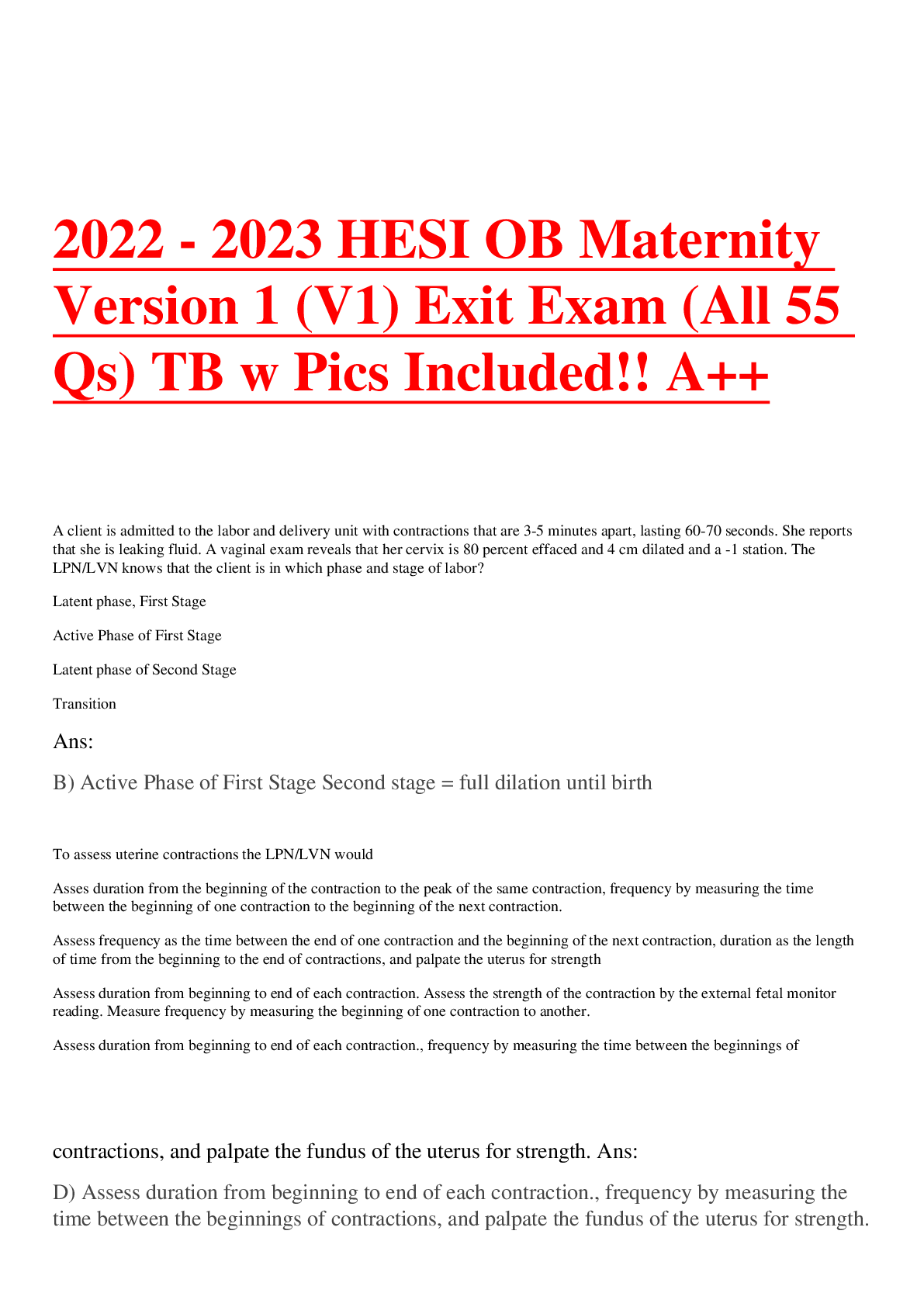

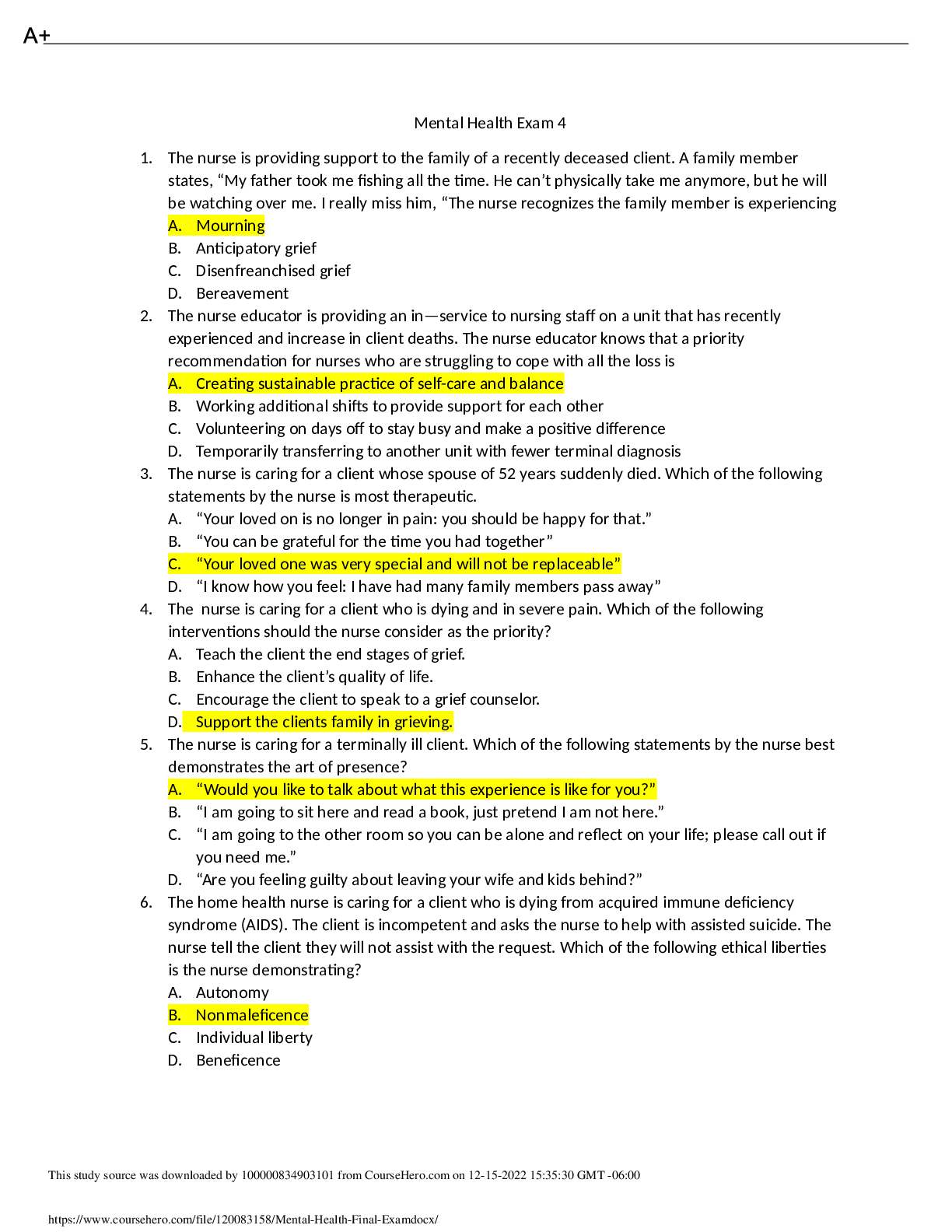

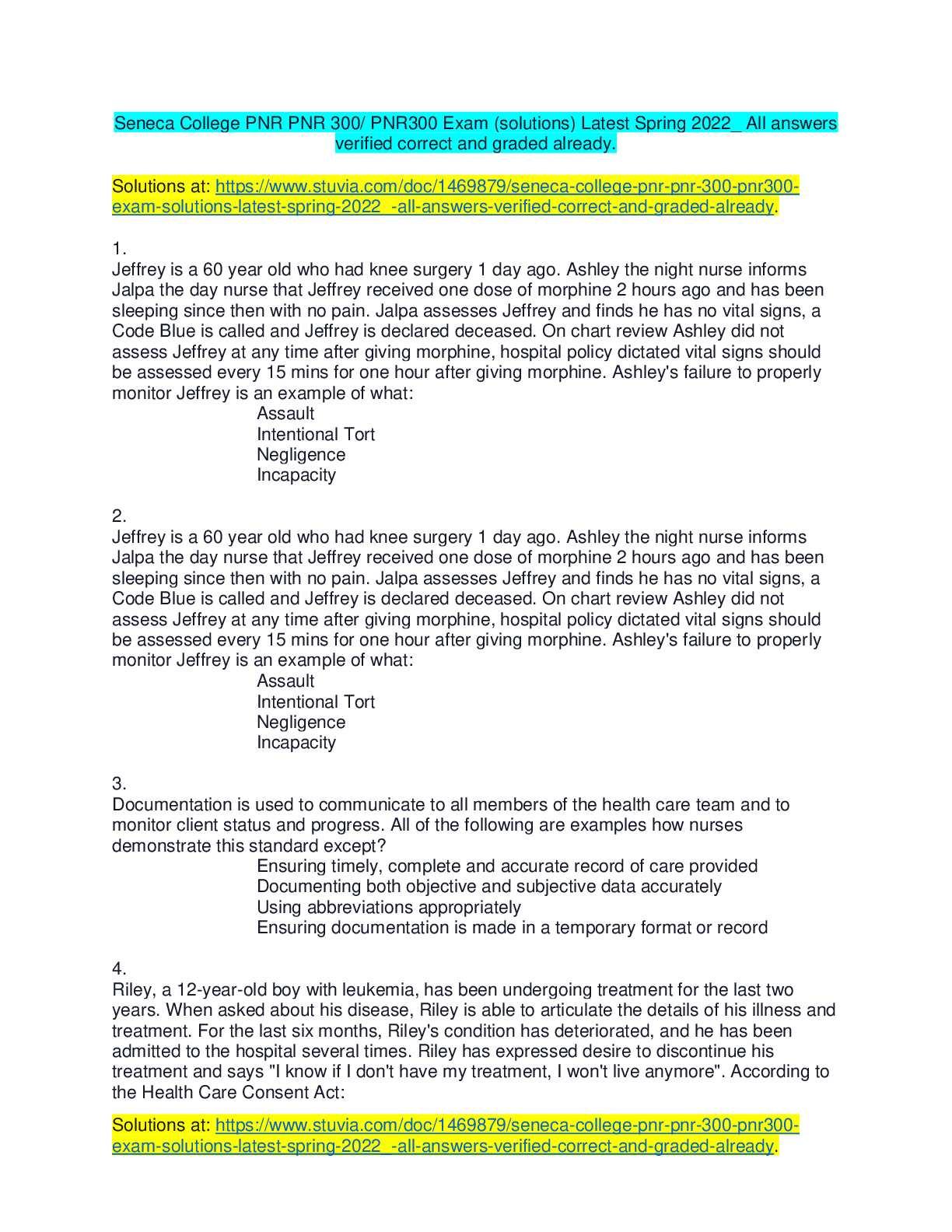
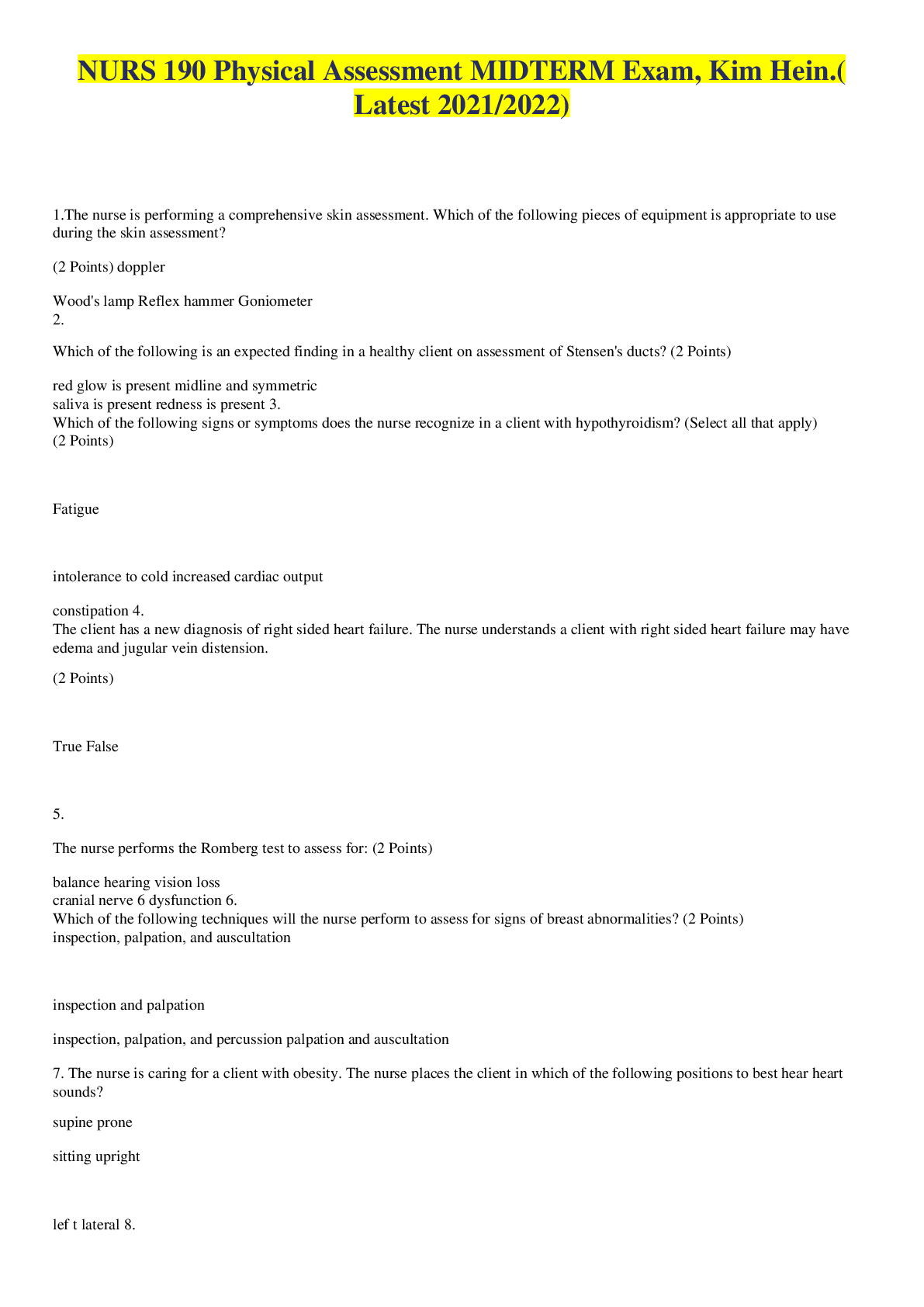


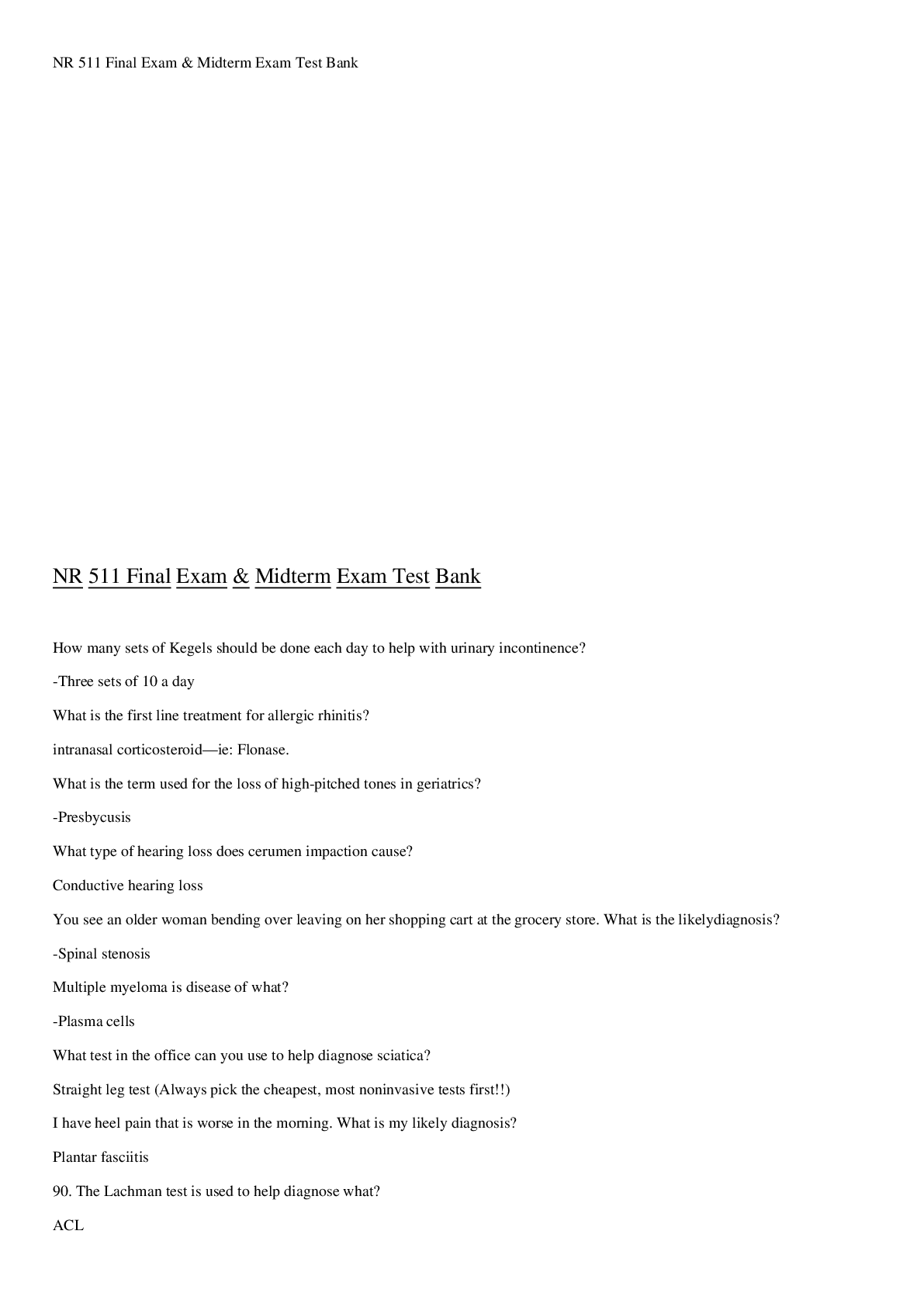


.png)


 Exit Exam Questions & Answers.png)





